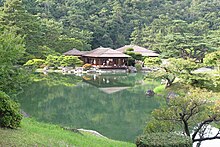Ritsurin Park
The Ritsurin Park ( Japanese 栗林 公園 , Ritsurin-kōen , literally "Chestnut Grove Park") on the outskirts of the city of Takamatsu is the largest convertible garden in Japan with almost 75 hectares . He is one of the "Excellent Sights" ( tokubetsu meishō ) of the country.
history
In the Genki Tenshō period (around 1575), the wealthy Satō family who lived there built a garden in the southwest part of today's park. Then around 1625 the prince ( daimyo ) of Takamatsu in the province of Sanuki , Ikoma Takatoshi , took over the garden and expanded it to include the area that is today on the "Southern Lake". 1642 Prince Matsudaira Yorishige was entrusted with the fiefdom ( Han ), he continued the development of the garden.
The following Matsudaira also continued the maintenance and expansion of the garden until, after a hundred years, it was given its final shape in 1745 under Yoritaka . Up until the Meiji Restoration in 1868, a total of eleven generations of the Matsudaira used the garden as a secondary residence ( shimo-yashiki ). After 1868 the Matsudaira of Takamatsu were raised to the new nobility ( kazoku ). Count Matsudaira Yorinaga (1874–1944) is honored with a monument in the park.
In 1871 the Takamatsu-han was dissolved, the park first came into the possession of the new government and was then opened to the public on March 16, 1875. The prefecture erected exhibition buildings with folk art of the prefecture ( 讃 岐 民 芸 館 , Sanuki Mingeikan ) and a building to promote the economy and trade ( 商 工 奨 励 館 , Shōkō Shōreikan ). Both buildings are located in the northern part of the park.
The park
The park extends north-south in front of Mount Shiun ( 紫雲山 , -zan ) in the west , which is used as a "borrowed landscape" ( 借 景 , shakkei ). The park is divided into a north and a south park, but they merge into each other without any visible border. With a "Northern", "Western", "Southern Lake", "Duck Pond", "Kansui Pond", "Lotus Water" (named here with the old name for Lotus, Fuyō ) and other small ponds, the park shows an unusually large number of bodies of water. They are all connected to each other and some of them are navigated by boats. The waters are crossed by a correspondingly large number of bridges, including the "half moon" or "arched bridge" ( Engetsu-kyō ).
Attractions
The northern part has in addition to the above-mentioned buildings u. a. the following sights:
- Tsuru-kame-matsu ( 鶴 亀 松 ): 100 pine branches in the shape of a turtle give the shape of a crane,
- Kamobiki hori : digging for duck fishing at the duck pond.
The older southern part has u. a. the following buildings and sights:
- Higurashi-tei : an old pavilion from the Edo period and a new one of the same name from 1898,
- Kōbusha : area for military exercises (archery),
- Hōbiu : hill with "phoenix tails" = Sotetsu (cycas revoluta),
- Kikugetsu-tei : tea pavilion from the early days of the park,
- Hako-matsu , Byōbu-matsu : black pines, the branches of which have been cut into geometric shapes,
- Shofuda : a hill loosely covered with stones, probably the oldest part of the park,
- Fukiage : the large spring pond, the water supply for the park,
- Hiraihō , Fuyōhō : two hills on the eastern edge of the southern park.
The year and its blossoms
| Month (s) | blossom | annotation |
|---|---|---|
| February | Camellias | all over the park |
| February March | Plums | North and south woods, approx. 200 trees |
| March | Magnolias | at the Shobuda |
| April | Cherries | about 350 trees in the whole park |
| May | Wisteria various azaleas Iris |
at the old Higurashi-tei in the whole park, approx. 2300 bushes at the Shobuda |
| June | Irises | approx. 3000 perennials at the duck pond |
| July | Yabu-kanzo No-kanzo |
at the Seikei watercourse at Shosan, Kansui Pond |
| July August | lotus | in Fuyō waters |
| September | Bush clover | all over the park |
| November | maple | on the maple shore ( kaedegishi ) |
Characteristics
- Carrier: Kagawa Prefecture
- Opening: March 16, 1875
- Area: 748,749 m²
- Plants: a few thousand trees and bushes
- Facilities: numerous teahouses or pavilions, exhibition buildings, restaurants
- Access: chargeable
Remarks
- ↑ Yorishige was an older brother of Lord Tokugawa Mitsukuni , head of the Mito family .
- ↑ For example: "Pond immersed in the green".
- ↑ Yoritaka gave the tea house its current name after a Chinese poem: "If you scoop the water with both hands ( kiku ), you hold the moon ( getsu ) in your hands."
- ↑ Two types of daylily .
swell
- Leaflets of the garden in Japanese, English, German
Web links
- Official website (English / Japanese)
Coordinates: 34 ° 19 ′ 46 ″ N , 134 ° 2 ′ 38 ″ E





